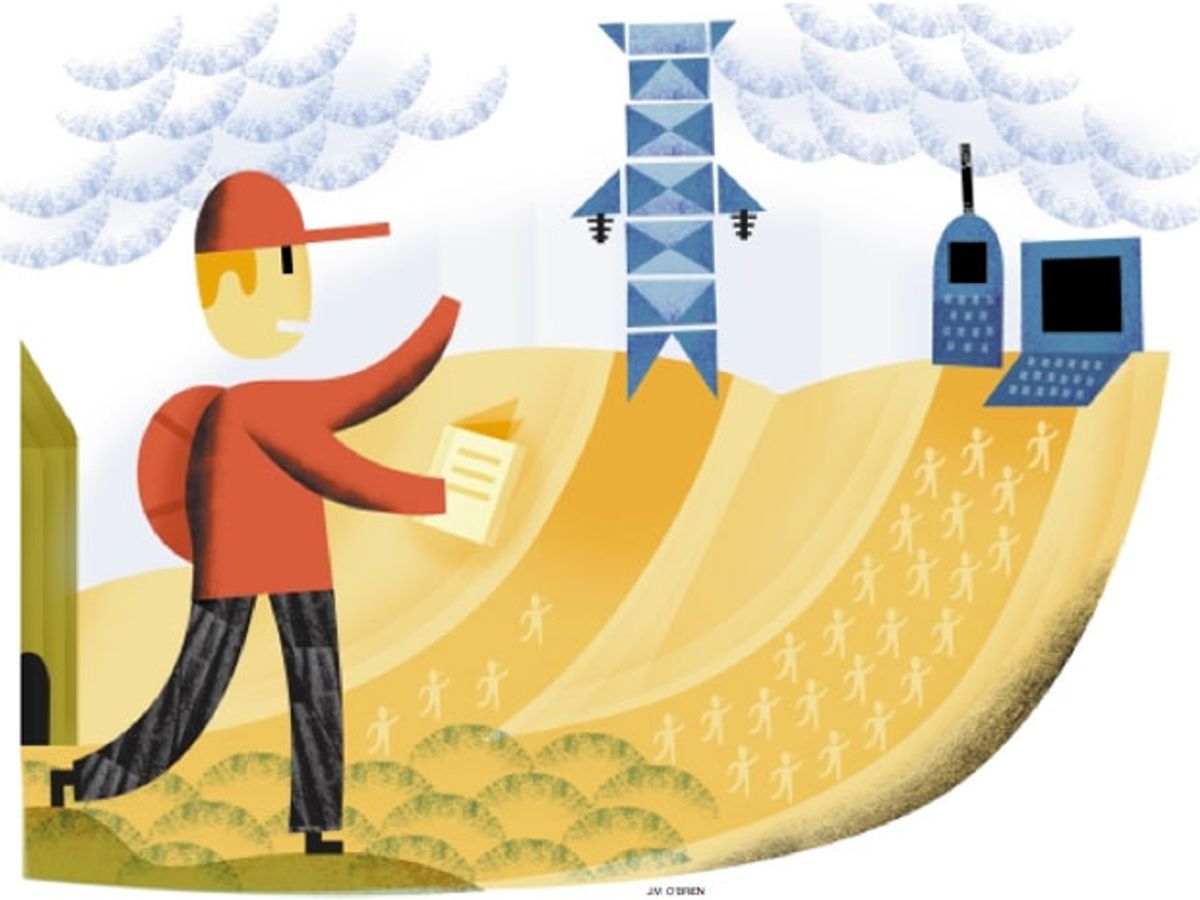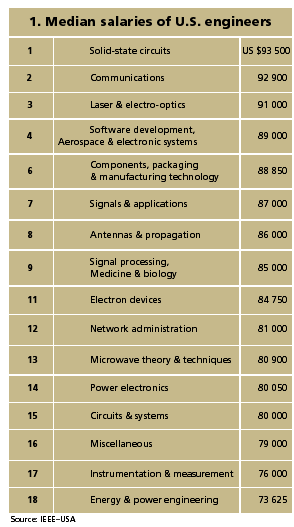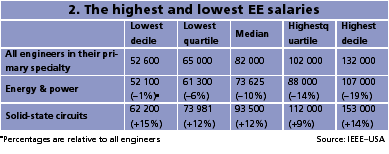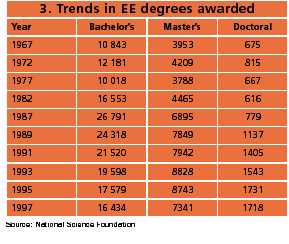Power Education at the Crossroads
Though students tend to favor higher-tech and more lucrative fields than power engineering, reports of the discipline's demise are exaggerated

The electric power industry in the United States is facing a disquieting shortage of trained engineering personnel. For decades, things have gone downhill. The salaries paid to power engineers have been lower than those of virtually all other electrical engineers. Student enrollments have steadily declined. University programs have atrophied.
To top things off, as the electric power industry has been radically reorganized in the last 10 years to allow for greater competition, utilities have economized by cutting staff, even as the technical requirements of running their operations have become spectacularly more demanding. While power engineering has continued to attract engineering school students overseas, where positions in industry enjoy prestige and competitive salaries, the effect has been to aggravate the situation in the United States.
"After spending the last decade on downsizing, rightsizings, re-engineering, business process improvements, and trying to meet the next quarter's earnings goal, there is an immediate critical shortage of power engineers required to perform basic transmission and distribution planning and engineering," said Carl Mycoff, head of Mycoff & Associates, a leading placement firm that specializes in putting power engineers to work. Mycoff, based in Denver, Colo., expects the shortage of power engineers to worsen noticeably over the next five years.
The essence of the problem, as seen by Mycoff and other experts in the industry, is that the introduction of competition in electric power requires a whole new set of skills. "Worldwide project management, resource exploiting, wholesale and retail electricity marketing, reactive power management, and other ancillary support systems are among the areas demanding new graduates," said William Guyker, director of planning and research at Allegheny Power, an energy company based in Fairmont, West Va. "We need to be perceptive and forecast the future industry needs and have some stomach for designing curricula that match new academic requirements with these needs."
In the long run, attracting the right kinds of students into the right training programs will depend on salaries rising. While considerable anecdotal evidence suggests that pay may already be improving, none of the available statistics is sufficiently up-to-date or fine-grained to demonstrate a new trend conclusively. Still, considering how excessively the prestige of power engineering has dropped in the United States, there is hardly any way to go but up.
Changing technical challenges
Although power engineering has not retained the status it once enjoyed among students and the faculty who train them, it remains the lynchpin of a huge industry on which virtually all other industries rely.
The leading power engineering companies—General Electric, Siemens, Alsthom, and ABB—are among the world's biggest and most prestigious corporations. To be sure, the power-related business segment makes up only a fraction of what these highly diversified companies do. But that segment still represents a large and rapidly growing market—not a week goes by, indeed, without the announcement of some major international power transaction involving one of those companies.
Platts Utility Data Institute, a division of Mc-Graw-Hill in New York City, predicts that over the next 10 years more than 750 GW of new generating capacity will be installed worldwide, requiring an investment of US $500 billion. That scenario represents a huge opportunity, not only for plant manufacturers but also for providers of energy services.
With deregulation of the gas and electricity industries in the 1990s, a new breed of company appeared— the comprehensive energy services company. Firms like Enron and Southern Company Services, to name just the two that appear most in the headlines of the business press, are leading suppliers of power generation technology, sellers of electricity and fuels, and providers of business consulting and energy management services. Such companies compete globally, regardless of where they are based, and they are all aggressively investing in information technology systems and e-business development.
In fact, the advent of new high-tech management systems—and the need for engineers able to design and deal with them—is evident in the very core of power system operations: the control centers, where there is an unobtrusive blending of state-of-the-art communications technology, computer hardware, computer networking, and sophisticated application software. New control algorithms based on intelligent controls incorporating fuzzy logic, neural networks, and genetic algorithms are being slowly introduced. Devices based on power electronics are making power transmission safer and more reliable, and the Internet is making power marketing more convenient. With companies using the Internet to perform operations more efficiently, and with a wide array of products to sell, they need engineers with diverse backgrounds.
Not only is the electric power industry generating much new technology itself, it is also an important consumer of new technologies produced by other electrical engineering disciplines. This emphasis on technological know-how will require people trained to work in these areas, as well as innovators whose creations must respond to changing requirements for electric power systems.
Where we are, how we got here
Though some engineers in and near the electric power industry remain unconvinced that an impending shortage of trained personnel really exists, the problem seems obvious to most of the experts interviewed for this article. As they see it, indeed, the shortage is not something that has suddenly appeared in view. It has been in the making for decades.
U.S. utilities and power engineering companies already were trimming staff by the mid- to late-1980s because of declining growth rates in electricity consumption—at about 2.5 percent, annual increases in demand were half what they were in the early '70s. Then, as commercial pressures grew with deregulation, utilities trimmed further. Increasingly they maintained only skeleton engineering staffs to manage day-to-day needs, reduced or eliminated internal R&D budgets, and stopped funding university research.
In making such decisions, utility managers often reasoned that the introduction of tools that made engineers more productive meant that the same tasks could be completed with fewer trained engineers. While there was an element of truth in that thinking, it failed to take into account dramatic changes in the business—the countless new tasks that were introduced in the late 1990s. An engineer who 10 years earlier might have designed only software might now be asked to participate in making both technical and business decisions. But today's managers, lulled by decades of slow economic and technical growth, are unaccustomed to paying the salaries and offering the benefits required to attract such engineers.

Regular surveys carried out by IEEE-USA show that salaries for engineers working in power and energy have lagged badly behind salaries in most other fields of electrical and electronics engineering [Table 1]—and that the lags have become worse the further along the engineers are in their careers [ Table 2]. Yet there are plenty of close observers who believe the industry salary situation is getting brighter.

"Power engineers with rounded backgrounds can command high salaries," said Dave Little, manager of a recruiting firm that places power engineers. "The driving factor is interpersonal skills. Individuals, regardless of national origin, are in greater demand to the extent they communicate well, and interact well with others."
This also is the assessment of Thomas Garrity, manager of business development at GE Harris, Melbourne, Fla., and a long-time General Electric engineering executive who has participated in international workshops on workforce needs. He noted that power engineers who have the right background and experience—and particularly an ability to operate effectively in an international business environment—can actually command higher salaries than engineers in other fields.
Graduating students with bachelor's degrees in electric power engineering are offered, at present, salaries in the range of $41 000 to $50 000, judging from individuals contacted at various government and nongovernment agencies. Among those contacted were engineering managers and other officials at organizations such as PacifiCorp, the Tennessee Valley Authority, Bonneville Power Administration, the U.S. Bureau of Reclamation, Black & Veatch, New Century Energies, and Duke Energy.
These starting salaries are low by the standards of the whole field of electrical and electronics engineering. But some job openings are going unfilled at the salaries offered, indicating a shortage of qualified power engineers now.
Recruiters who have hired new graduates almost unanimously said they would have liked to see recruits with a stronger power system background plus a combination of computer skills, project management potential, ability for teamwork, and interpersonal skills. "They are prepared to accept their technical responsibilities, but they are not prepared to accept their business responsibilities," one recruiter said, referring to recent recruits.

A lack of adequately skilled graduating college students may partly explain why demand is higher for those with advanced degrees [ Table 3]. Neither trend—the drop in bachelor's degrees in electrical engineering, the growing popularity of advanced diplomas—is altogether wholesome. "There is too much emphasis on the higher post-graduate degrees," said John Mountford, manager of the planning department at Power Technologies Inc., Schenectady, N. Y. "The power industry—both utilities and manufacturers—hires bright people [with college degrees] who are recognized as needing ongoing training. The keys to hiring are good references from a respected tutor, communication skills at the interview, and gut feelings."
Collapse of U.S. enrollments
While statistics tracking specific developments in power engineering employment and education are lacking, there is little doubt as to the general trend.
Frank Merat, interim chair of the electrical engineering and computer science department of Case Western Reserve University in Cleveland, Ohio, reported that of 30-50 graduating students each year, at most just one goes into power engineering.
Barry Farbrother, head of electrical and computer engineering at Rose-Hulman Institute of Technology in Terre Haute, Indiana, reported much the same experience. "We have a good relationship with the utility companies in the Midwest who regularly hire our power engineering graduates. However, enrollment in power courses is showing a decline. I have three faculty members who teach power courses, out of a total of 18." Furthermore, said Farbrother, "If one of the power faculty were to retire or leave, I would not replace him with another power person but with someone who has VLSI [very large-scale integration] or electromagnetics expertise."
Up until 1999, the undergraduate program in the electrical engineering department at Rutgers University in New Brunswick, N.J., had a required course in electrical energy conversion with a laboratory. After the fall 1999 semester, the course had become an elective and the laboratory was completely removed from the program. "The move to discontinue the required course was in response to the trend in the country away from power-related courses and the retirement of our only faculty member in the power area," said David Daut, head of the EE department. "For all the elective courses in the power area, enrollments have been on the order of five to eight students out of class sizes of 120 or more."
Perhaps because the United States has been in the forefront of the revolutions in microelectronics, digital computing, and packet communications, power engineering has fallen into a darker shadow than elsewhere. Students' concerns about the environment also play a role. Coal, oil, and gas power generation is considered a source of global warming and acid rain, while nuclear power is seen as accident-prone and a generator of radioactive waste—and, therefore, downright dangerous.
A beckoning beacon elsewhere
Outside the United States, in contrast, power engineering seems to be getting on rather well in both industry and academia. Some western European countries are ahead of the United States in the race for deregulation of the power industry, and even where they are not—France, notably—the power engineering profession enjoys much greater prestige.
The Europeans have also done more to integrate academic programs with industry goals. In Norway, Sweden, the United Kingdom, and other countries, a majority of graduate students and faculty members conduct research in close consultation with industry. In many instances, industry has a financial stake in research activities at universities.
"Universities have to understand the necessity to work on problems that can, in both the long and short run, improve the economic result of the utilities," said Sture Lindahl, an engineer who worked for the Swedish utility Sydkraft for many years and is currently with ABB Sweden, in Västerås. Lindahl noted that industry expects fast results. "Five years is a long time for managers in companies subjected to competition," he said. "The next quarter and the next year are important for the investors."
"By tradition there has been very good cooperation between the electric power industry and the universities in Sweden," said Göran Andersson, a professor at the Royal Institute of Technology in Stockholm. "For Ph.D. student projects, committees are formed with supervising faculty members and suitable industry engineers. One of the most important tasks of these committees is to guide the student, and the faculty supervisor, so that the work performed is of interest to the industry."
An article published in a recent issue of the newspaper of Berlin's Technical University noted that bulletin boards there are replete with postings of open positions in energy system engineering, and that such positions often command top salaries.
Competing demand for power engineers
The higher status power engineering enjoys outside the United States is no doubt one important reason why universities in the United States have found it easier to attract graduate students from outside the country into graduate power engineering programs than it is to recruit U.S.-born students (though, let it be noted, the same pattern is found in all fields of science and technology). Power engineering graduate students born outside the United States outnumber their U.S.-born colleagues by more than three to one, panelists reported at the IEEE Power Engineering Society Summer Meeting held in Edmonton, Alta., Canada, in July 1999.
According to a brief issued by the National Science Foundation's Division of Science Resource Studies in February 1999, about 17 percent of working U.S. engineers were non-native born. Yet 53 percent of those foreign-born engineers had attained a postbaccalaureate degree versus 29 percent of native-born engineers.
U.S. dependence on foreign-born graduate students to fill U.S. jobs has become an aggravating factor in finding recruits because many foreign-born engineers educated in North America are being lured back to their home countries.
In India, China, and other developing countries, state or federal governments own the electricity companies. These "electricity boards" hire a large number of graduates every year to look after power systems that are struggling to keep up with sharply increasing electricity demands while staying abreast of the latest in technology.
Asiaweek, in its 16 July issue last year, reported an increase in Asian students returning to their respective home countries because of the perception of an improved social standing there, as well as emerging opportunities. The story, entitled "Homeward Bound," recounted the experiences of native Chinese engineers who, after earning their degrees, returned to their homeland.
One of the students profiled, the authors write, "was part of the great student exodus that began in the early 1980s, when the late patriarch Deng Xiaoping encouraged the best and the brightest to go overseas, learn and then bring back the intellectual motherlode to the motherland." While still doing graduate work at the University of Southern California in Los Angeles, the student began hearing about changes in Chinese society—like tolerance of dissenting views and intellectual independence, not to mention the potential to make millions of dollars as an entrepreneur in an emerging market economy. With those changes, China seemed as attractive a place to work as the United States and Europe. The student eventually moved to Shanghai to work, moonlighting as a recruiter for a headhunter that seeks out Chinese students who also studied overseas and are hoping to return home.
China's efforts at repatriating its greatest minds seem to be paying great dividends. David Zweig, a professor at the Hong Kong University of Science and Technology and coauthor of the book China's Brain Drain to the United States (Institute of East Asian Studies, University of California, Berkeley, 1995), told an interviewer in 1999 that since 1994, the number of engineering graduates choosing to return to China had grown 15 percent each year.
Revamping the curricula
Reversing the trend of diminishing U.S. student interest in electric power will not be easy. A workshop convened recently by the National Science Foundation (NSF), in Arlington, Va., highlighted some actions that could make the discipline more challenging and university curricula more industry-friendly. Among such activities are using simulation and visualization tools wherever possible; including economics, business, and communication topics in power engineering courses; introducing electric power concepts in basic and elective electrical engineering courses; and making power curricula flexible enough to prepare students for a changing work environment.
Many electrical engineering departments have already started to revamp their power engineering curricula. Already there is a trend to include power electronics, renewable energy, and the environmental impacts of power generation in the main power engineering topics. At some schools, certain energy concepts are being integrated into lower-level required courses, such as those in linear systems and fields theory.
Computer simulations make it easier for students to grasp some of the more difficult concepts related to electromagnetics, while interactive learning, group design projects, and participation in class activities via the World Wide Web are becoming more common. The inclusion of courses detailing the business implications of power engineering is beginning to draw the attention of students with entrepreneurial ambitions.
At the University of Canterbury in New Zealand, where student numbers in power engineering had been decreasing since 1992, the department managed to reverse the trend by 1997. Its solution was to introduce aspects of power-electronics applications, such as high-voltage dc transmission, into power engineering courses. Britain's University of Manchester Institute of Science and Technology is expanding its research activities in the high voltage and power electronics areas.
Cross-disciplinary strategies
Another promising approach is to promote disciplines and topics that may not have "power engineering" in the title but can be easily related to power. NSF recently announced a $3 million initiative on Engineering the Transport Industries. Discussing it, Marija Ilic, the agency's program director for integrative systems, hoped it would be taken by power engineering professors as an opportunity to re-think the design and operation of large-scale electric power networks and try to generalize the methods being applied to larger classes of transport networks. Said Ilic: "All transport networks share inherent commonalities. They are generally very complex systems whose individual components are interconnected in a graph-like manner."
Clearly, coordinating power engineering courses with other core electrical engineering areas could prove beneficial. At the University of Missouri-Rolla, several power engineering faculty are involved in multidisciplinary research initiatives that combine electromechanics, power electronics, electromagnetic compatibility, vibrations, and audible noise as applied to the design of electric and hybrid vehicles. These activities are, in turn, leading to lecture topics and lab exercises at the undergraduate and graduate levels. The school's traditional electric machines course has been converted into an introductory electric drives course focused on the principles of electromechanics with an emphasis on control aspects—an area that is gaining more R&D funding from industry.
Such a multidisciplinary approach is also being taken at Purdue University and the University of Illinois at Urbana-Champaign. At other places, senior electives are geared toward courses that students can use in a senior design project such as hybrid electric vehicles or solar cars. Projects like these call on a varied body of knowledge relative to electric drives and power management—and they generate student interest because they emphasize real-world applications.
At Ohio State University's electrical engineering department, power area courses now include mechatronics (which combines mechanical and electrical engineering), power electronics, high voltage engineering, and electric machine modeling and control, alongside traditional courses in power system analysis and design.
To be sure, some of the devices used by university administrators to revive interest in power are merely cosmetic, like changing course names. But real financial commitments are also being made. The University of Waterloo in Canada is expanding its faculty base in the areas of power markets and power electronics applied to mechatronics. Michigan State University's electrical engineering department is also looking to hire a new professor in power electronics.
A special automotive initiative program begun at Michigan State "allowed us to hire a replacement [in power engineering] for a retired faculty member," said Robert Schlueter, an EE professor at the university. "Hiring someone in power electronics makes excellent sense because the electric and hybrid options for cars and trucks are just in their infancy at the moment. The power system analysis course will also be continued because of the strong resurgence in hiring by local utilities."
Pooling resources and talent
Some university groups are combining resources for better utilization of expertise in power. Examples are the Advanced Control of Energy and Power Systems and the Power Systems Engineering Research Center, two consortia of universities and industrial partners that focus their support on finding solutions to help the next-generation electric power systems. (The first comprises institutions in Arizona, Colorado, and Kansas; the second, three major universities and three large utilities.)
Last year, through another group effort, the Engineering Research Center in Power Electronics was established. Sponsored by NSF, it is based at the Virginia Polytechnic Institute and State University in Blacksburg. The center combines power area courses with finance and business administration, and its staff reports that many students find this aspect of power attractive.
In another venture, seven U.S. universities are leading an effort sponsored by NSF and the Electric Power Research Institute in Palo Alto, Calif., to develop better power curricula. These will incorporate active learning, multimedia course modules, digital simulation tools, and cooperation from other EE areas.
Funding for power engineering R&D is also not as scarce as some might believe. Granted, the core amount allocated for power-related research by the NSF has diminished over the years, but candidates with proposals, using careful planning and imagination, can still obtain funds. Arthur Sanderson, past director of the NSF's Division of Electrical and Communications Systems, said that the "division still encourages proposals in both power systems and power electronics areas. We are especially interested in new approaches to power systems analysis which take advantage of emerging technologies for distributed systems and networks analysis for large-scale systems."
While the shortage of trained power engineers continues to vex the power business environment, these changes in educational approaches bode well for an industry intent on moving full steam ahead into a deregulated environment.
Spectrum editors: Willie D. Jones & William Sweet
About the Author
Badrul H. Chowdhury is a professor in the electrical and computer engineering department of the University of Missouri-Rolla. From 1996 to 1998, he was a principal investigator for a project aimed at revitalizing power engineering education, sponsored by the U.S. National Science Foundation and the Electric Power Research Institute.
To Probe Further
The panel session, "Review of electric power engineering education worldwide," was published in Proceedings Of the IEEE Power Engineering Society Summer Meeting, held 18-22 July 1999, in Edmonton, Alta., Canada.
For more on U.S. jobs for non-U.S. engineers, see "How much does the U.S. rely on immigrant engineers?" by Lawrence Burton and Jack Wang, National Science Foundation, NSF 99-327, issued 11 February 1999.
Three reports detailing electric power engineering resources, done by the IEEE Power Engineering Society Educational Resources Subcommittee, appear in the IEEE Transactions on Power Systems. The 1993-94 report came out in Vol. 11, no. 3, August 1996, pp. 1146-58; the 1991-92 report, in August 1994, Vol. 9, no. 3, 1182-93; and the 1989-90 report, in November 1992, Vol. 7, no. 4, pp. 1611-22.